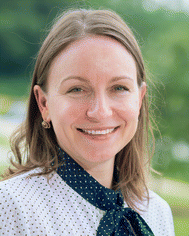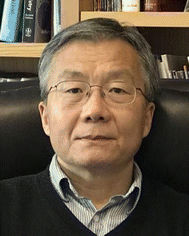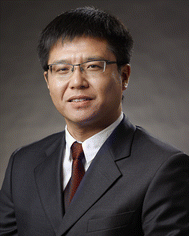Introduction to CO2 capture and conversion
Elena
Shevchenko
*ab,
Ah-Hyung Alissa
Park
c,
Shouheng
Sun
d and
Tierui
Zhang
ef
aCenter for Nanoscale Materials, Argonne National Laboratory, Argonne, Illinois 60439, USA. E-mail: eshevchenko@anl.gov
bDepartment of Chemistry and James Frank Institute, University of Chicago, Chicago, Illinois 60637, USA
cDepartment of Earth and Environmental Engineering, Department of Chemical Engineering, and Lenfest Center for Sustainable Energy, The Earth Institute, Columbia University, New York, New York 10027, USA
dDepartment of Chemistry, Brown University, Providence, Rhode Island 02912, USA
eKey Laboratory of Photochemical Conversion and Optoelectronic Materials, Technical Institute of Physics and Chemistry, Chinese Academy of Sciences, Beijing, 100190, China
fCenter of Materials Science and Optoelectronics Engineering, University of Chinese Academy of Sciences, Beijing, 100049, China
Abstract
An introduction to the Nanoscale themed collection on CO2 capture and conversion, featuring exciting research on advanced nanoscale materials and reactions.
Greenhouse gases such as carbon dioxide (CO2), methane, nitrous oxide, and fluorinated gases (hydrofluorocarbons, sulfur hexafluoride, nitrogen trifluoride, perfluorocarbons) are entering the atmosphere in different quantities as a result of anthropogenic agricultural and industrial activities. All these gases can trap heat in the atmosphere resulting in global warming. Despite CO2 having the lowest global warming potential (GWP),1 a measure used to compare the abilities of different gases to trap heat in the atmosphere, it is the most significant greenhouse gas because of its longevity in the atmosphere and the enormous amount released into the atmosphere as a result of large scale burning of fossil fuels for energy and manufacturing uses. The potential impact from CO2 emitted to the atmosphere could linger for much longer than that of other greenhouse gasses.2
The correlation between the increase in atmospheric CO2 and higher surface temperature was first proposed by Arrhenius in 1896.3,4 In 1938, Callendar demonstrated that the Earth's land surface was warming and attributed this phenomenon to the production of CO2 by the combustion of fossil fuels.4 In 1971, Sawyer raised the concern that mass discharge of CO2 from human activities could affect the heat balance of the Earth.5
There were about 34.9 Gt CO2 emitted in 2021.6 The sustainable natural ways of sequestering CO2 from the atmosphere through photosynthesis by plants, carbonate formation via CO2 binding with minerals and adsorption of CO2 by water can provide 37% CO2 mitigation needed through 2030 for a >66% chance of holding warming to below 2 °C.7 While forestlands, swamps, soils and oceans can partially remedy the adverse effects of the released CO2, they cannot combat climate change. In addition, the elevated levels of CO2 can affect photosynthesis, carbon partitioning,8 and acidification of oceans.9 Therefore, deep decarbonization of the global economy is required for realization of both the 2.0 °C and 1.5 °C scenarios9 that restrict warming to 2.0 °C or 1.5 °C above preindustrial levels in order to mitigate the most dangerous and irreversible effects of climate change. This will require both climate policy reinforcements10 and innovation in materials design and technologies. However, since major changes in industrial practices and human behavior are not expected to occur in the next few decades,11 scientific breakthroughs in CO2 capture, conversion, storage, and utilization are the most promising game-changers that can alter the trajectory of rapid deterioration of the global environment.
One of the biggest obstacles in CO2 mitigation is its capture from dilute sources.12 CO2 capture from dilute sources using advanced sorbents and its further conversion into carbon-based chemicals and fuels is recognized as a necessary step in addressing the continuous increase in CO2 release into the atmosphere. Currently implemented large scale post-combustion amine scrubbing technology13 based on formation of carbonate salts with amines suffers from a few drawbacks such as high consumption of water, degradation of solvents and corrosion of the equipment. High surface area sorbents, including macromolecule structures, are currently being explored as a class of materials to replace amine scrubbing technology.
While CO2 utilization as a feedstock can be seen as a cleaner alternative to hydrocarbons in industrial or chemical processes,14 its successful implementation at scale faces economic challenges. The issue is that CO2 is a highly stable molecule that requires significant energy input for CO2 valorization. For example, dry methane reforming, a conversion process of carbon dioxide and methane (the two main gases responsible for global warming) known since 1928,15 can play an important role in meeting global energy and climate goals.16 However, catalytic dry methane reforming takes place at very high temperatures and high pressures which challenges the stability of the catalysts. The water–gas shift17 and lower temperature Sabatier18 reactions producing carbon monoxide and methane (lower value), respectively, from the reaction of CO2 with hydrogen have attracted renewed interest as possible processes for mitigation of CO2.17,19 These reactions also require high temperatures and restriction of the production of undesired products. More active, stable, and selective catalysts are needed to make CO2 valorization through thermochemical routes become an economically suitable technology at scale.
Upgrading CO2 to hydrocarbons using renewable energy sources is a promising solution for closing the carbon cycle. The chemical and physical principles of heterogeneous photocatalytic CO2 transformation are rather well understood; however, significant improvements in the efficiency of optochemical engineering of CO2 photocatalysis at scale are required.20 Photoactive catalysts can also be designed from enzymes and bio-organisms such as algae and bacteria. Electrochemical transformation of CO2 into hydrocarbons is another attractive carbon net-zero process as the electricity required to catalyze the process can be easily obtained from renewable sources.21,22
Understanding CO2 capture and conversion has been essential in our efforts to build a carbon neutral/negative society and to achieve energy sustainability. Recent studies have shown that CO2 can be captured from industrial waste in more energy efficient manners and be converted more selectively via various catalytic processes to reusable chemicals and fuels. This themed issue invites experts in the field to publicize the latest state-of-the-art progress they have made in CO2 capture and conversion. Their work focuses on selective CO2 capture via carbonate formation, and CO2/carbonate conversion via thermochemical, electrochemical, photochemical, and biological means to reusable forms of carbon. The collection also includes papers aiming to understand structure–property correlation to further improve the capture and conversion efficiencies. We hope you enjoy reading these articles and find them useful in your on-going endeavors in CO2 capture and conversion.
References
- https://en.wikipedia.org/wiki/Global_warming_potential .
- M. Inman, Carbon is forever, Nat. Clim. Change, 2008, 1(812), 156–158 CrossRef.
- A. E. Dessler, Introduction to Modern Climate Change, Cambridge University Press, 2021 Search PubMed.
- E. Hawkins and P. D. Jones, On increasing global temperatures: 75 years after Callendar, Q. J. R. Meteorol. Soc., 2013, 139(677), 1961–1963 CrossRef.
- J. S. Sawyer, Man-made Carbon Dioxide and the “Greenhouse” Effect, Nature, 1972, 239(5366), 23–26 CrossRef CAS.
- Z. Liu, Z. Deng, S. J. Davis, C. Giron and P. Ciais, Monitoring global carbon emissions in 2021, Nat. Rev. Earth Environ., 2022, 3(4), 217–219 CrossRef PubMed.
- B. W. Griscom, J. Adams, P. W. Ellis, R. A. Houghton, G. Lomax, D. A. Miteva, W. H. Schlesinger, D. Shoch, J. V. Siikamäki, P. Smith, P. Woodbury, C. Zganjar, A. Blackman, J. Campari, R. T. Conant, C. Delgado, P. Elias, T. Gopalakrishna, M. R. Hamsik, M. Herrero, J. Kiesecker, E. Landis, L. Laestadius, S. M. Leavitt, S. Minnemeyer, S. Polasky, P. Potapov, F. E. Putz, J. Sanderman, M. Silvius, E. Wollenberg and J. Fargione, Natural climate solutions, Proc. Natl. Acad. Sci. U. S. A., 2017, 114(44), 11645–11650 CrossRef CAS PubMed.
- M. Thompson, D. Gamage, N. Hirotsu, A. Martin and S. Seneweera, Effects of Elevated Carbon Dioxide on Photosynthesis and Carbon Partitioning: A Perspective on Root Sugar Sensing and Hormonal Crosstalk, Front. Physiol., 2017, 8, 578 CrossRef PubMed.
- B. Figuerola, A. M. Hancock, N. Bax, V. J. Cummings, R. Downey, H. J. Griffiths, J. Smith and J. S. Stark, A Review and Meta-Analysis of Potential Impacts of Ocean Acidification on Marine Calcifiers From the Southern Ocean, Front. Mar. Sci., 2021, 8, 584445 CrossRef.
- G. P. Peters, R. M. Andrew, J. G. Canadell, P. Friedlingstein, R. B. Jackson, J. I. Korsbakken, C. Le Quéré and A. Peregon, Carbon dioxide emissions continue to grow amidst slowly emerging climate policies, Nat. Clim. Change, 2020, 10(1), 3–6 CrossRef.
- S. J. Davis, K. Caldeira and H. D. Matthews, Future CO2 Emissions and Climate Change from Existing Energy Infrastructure, Science, 2010, 329(5997), 1330–1333 CrossRef CAS PubMed.
- A. Majumdar and J. Deutch, Research Opportunities for CO2 Utilization and Negative Emissions at the Gigatonne Scale, Joule, 2018, 2(5), 805–809 CrossRef.
- G. T. Rochelle, Amine Scrubbing for CO2 Capture, Science, 2009, 325(5948), 1652–1654 CrossRef CAS PubMed.
- C. Hepburn, E. Adlen, J. Beddington, E. A. Carter, S. Fuss, N. Mac Dowell, J. C. Minx, P. Smith and C. K. Williams, The technological and economic prospects for CO2 utilization and removal, Nature, 2019, 575(7781), 87–97 CrossRef CAS PubMed.
- A. Ramirez and J. Gascon, Support Was the Key to Success, Joule, 2020, 4(4), 714–716 CrossRef.
- K. Wittich, M. Krämer, N. Bottke and S. A. Schunk, Catalytic Dry Reforming of Methane: Insights from Model Systems, ChemCatChem, 2020, 12(8), 2130–2147 CrossRef CAS.
- X. Chen, Y. Chen, C. Song, P. Ji, N. Wang, W. Wang and L. Cui, Recent Advances in Supported Metal Catalysts and Oxide Catalysts for the Reverse Water–Gas Shift Reaction, Front. Chem., 2020, 8, 709 CrossRef CAS PubMed.
- M. González-Castaño, B. Dorneanu and H. Arellano-García, The reverse water gas shift reaction: a process systems engineering perspective, React. Chem. Eng., 2021, 6(6), 954–976 RSC.
- C. Vogt, M. Monai, G. J. Kramer and B. M. Weckhuysen, The renaissance of the Sabatier reaction and its applications on Earth and in space, Nat. Catal., 2019, 2(3), 188–197 CrossRef CAS.
- G. Ozin, Accelerated optochemical engineering solutions to CO2 photocatalysis for a sustainable future, Matter, 2022, 5(9), 2594–2614 CrossRef CAS.
- F. P. García de Arquer, C.-T. Dinh, A. Ozden, J. Wicks, C. McCallum, A. R. Kirmani, D.-H. Nam, C. Gabardo, A. Seifitokaldani, X. Wang, Y. C. Li, F. Li, J. Edwards, L. J. Richter, S. J. Thorpe, D. Sinton and E. H. Sargent, CO2 electrolysis to multicarbon products at activities greater than 1 A cm−2, Science, 2020, 367(6478), 661–666 CrossRef PubMed.
- O. S. Bushuyev, P. De Luna, C. T. Dinh, L. Tao, G. Saur, J. van de Lagemaat, S. O. Kelley and E. H. Sargent, What Should We Make with CO2 and How Can We Make It?, Joule, 2018, 2(5), 825–832 CrossRef CAS.
| This journal is © The Royal Society of Chemistry 2023 |





![[thin space (1/6-em)]](https://www.rsc.org/images/entities/char_2009.gif) 000 citations with an H-index of 96. He was named in the annual Highly Cited Researchers 2018–2021 List by Clarivate Analytics. Dr Zhang is an Associate Editor of
000 citations with an H-index of 96. He was named in the annual Highly Cited Researchers 2018–2021 List by Clarivate Analytics. Dr Zhang is an Associate Editor of